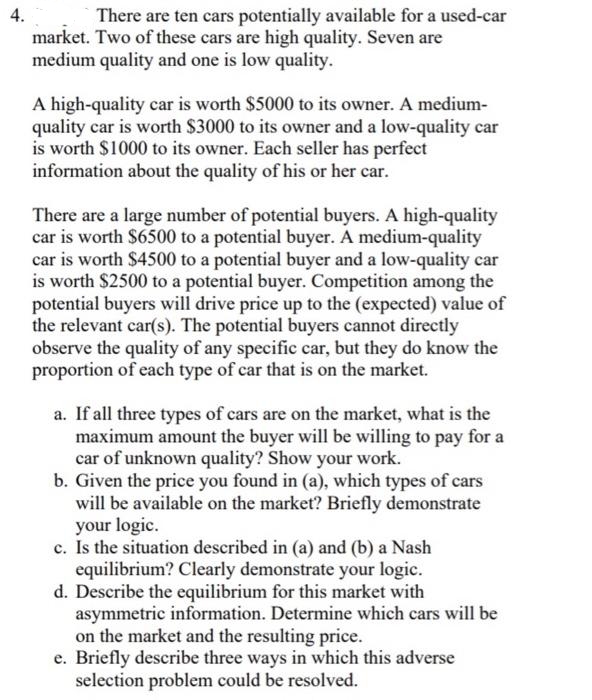4. There are ten cars potentially available for a used-car market. Two of these cars are high quality. Seven are medium quality and one is low quality. A high-quality car is worth $5000 to its owner. A medium- quality car is worth $3000 to its owner and a low-quality car is worth $1000 to its owner. Each seller has perfect information about the quality of his or her car. There are a large number of potential buyers. A high-quality
4. There are ten cars potentially available for a used-car market. Two of these cars are high quality. Seven are medium quality and one is low quality. A high-quality car is worth $5000 to its owner. A medium- quality car is worth $3000 to its owner and a low-quality car is worth $1000 to its owner. Each seller has perfect information about the quality of his or her car. There are a large number of potential buyers. A high-quality
Chapter14: Transaction Costs, Asymmetric Information, And Behavioral Economics
Section: Chapter Questions
Problem 3.8P
Related questions
Question
Plz all part a b c d e

Transcribed Image Text:4.
There are ten cars potentially available for a used-car
market. Two of these cars are high quality. Seven are
medium quality and one is low quality.
A high-quality car is worth $5000 to its owner. A medium-
quality car is worth $3000 to its owner and a low-quality car
is worth $1000 to its owner. Each seller has perfect
information about the quality of his or her car.
There are a large number of potential buyers. A high-quality
car is worth $6500 to a potential buyer. A medium-quality
car is worth $4500 to a potential buyer and a low-quality car
is worth $2500 to a potential buyer. Competition among the
potential buyers will drive price up to the (expected) value of
the relevant car(s). The potential buyers cannot directly
observe the quality of any specific car, but they do know the
proportion of each type of car that is on the market.
a. If all three types of cars are on the market, what is the
maximum amount the buyer will be willing to pay for a
car of unknown quality? Show your work.
b. Given the price you found in (a), which types of cars
will be available on the market? Briefly demonstrate
your logic.
c. Is the situation described in (a) and (b) a Nash
equilibrium? Clearly demonstrate your logic.
d. Describe the equilibrium for this market with
asymmetric information. Determine which cars will be
on the market and the resulting price.
e. Briefly describe three ways in which this adverse
selection problem could be resolved.
Expert Solution
This question has been solved!
Explore an expertly crafted, step-by-step solution for a thorough understanding of key concepts.
Step by step
Solved in 3 steps

Knowledge Booster
Learn more about
Need a deep-dive on the concept behind this application? Look no further. Learn more about this topic, economics and related others by exploring similar questions and additional content below.Recommended textbooks for you


Principles of Economics, 7th Edition (MindTap Cou…
Economics
ISBN:
9781285165875
Author:
N. Gregory Mankiw
Publisher:
Cengage Learning

Principles of Macroeconomics (MindTap Course List)
Economics
ISBN:
9781285165912
Author:
N. Gregory Mankiw
Publisher:
Cengage Learning


Principles of Economics, 7th Edition (MindTap Cou…
Economics
ISBN:
9781285165875
Author:
N. Gregory Mankiw
Publisher:
Cengage Learning

Principles of Macroeconomics (MindTap Course List)
Economics
ISBN:
9781285165912
Author:
N. Gregory Mankiw
Publisher:
Cengage Learning

Principles of Economics 2e
Economics
ISBN:
9781947172364
Author:
Steven A. Greenlaw; David Shapiro
Publisher:
OpenStax

Economics Today and Tomorrow, Student Edition
Economics
ISBN:
9780078747663
Author:
McGraw-Hill
Publisher:
Glencoe/McGraw-Hill School Pub Co
